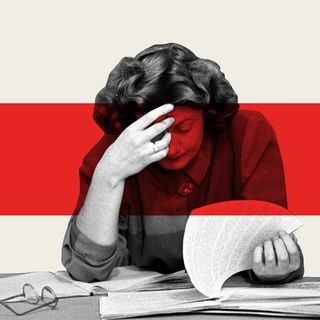
One Year Later, Are We at Risk of Forgetting the Lessons We Learned During the Pandemic?
It’s important we preserve the cultural memory of this crisis for lessons to make their way into our collective actions, discourse, and long-term policy.

“Today was more or less the same as yesterday, which in turn was the same as the day before,” Delhi-based Anandi Mishra writes in Lockdown Journal, a global archive of diary entries during the pandemic. Its founder, Sunila Galappatti, called the website a “brief history of moments indoors”; among others, there are accounts of lived history in the last one year: March 22’s Janta Curfew, India’s first 10,000 deaths, concerns of ‘corona jihad,’ online classes, family reunions through four-inch squares.
Anandi goes on to muse how when this is all behind us, we might demarcate our time as before and during Covid. That would certainly be a neat solution had the events of the lockdown not blended into one giant blob of … chaos. One year of staggering grief, solitary and collective, defies description.
This collective memory, however, is crucial for reasons that extend beyond making sense of it all on a personal level. On a societal scale, it is almost imperative for us to memorialize the pandemic — through media, tangible artifacts, personal anecdotes, and more — so we can take the lessons from this time into the future and turn them into long-term policy, action, and enduring conversation.
*
The experience of living through a Big Historical Event is one akin to existing in an exhibition window. On this side of the glass barrier, where the present is isolated, we are sentient mannequins living our lives on display. The watchful eye of the future was easy to ignore once the novelty of the pandemic wore off; if anything, the ‘history-in-the-making’ tag does all but disappoint. Being there in real-time for many momentous changes doesn’t guarantee an infallible account that can be remembered with confidence or accuracy.
Do you remember the events of January 27, 2020? Or does October 3 mean anything to you? Snapshots of working at odd hours, stray laments, Covid stories coming together in a frenzied mishmash. The precise memory of two milestones — India recording its first Covid19 case, or when we crossed 100,000 deaths, respectively — remains fuzzy and faint.
Related on The Swaddle:
Why Childhood Memories Are Vivid for Some, Hazy for Others
But the question of who remembers what will, of course, depend on whom you ask. Frontline workers — healthcare personnel, sanitation workers, police officials — people who have experienced the toll on human life first hand, are likely to experience some form of post-traumatic stress disorder (PTSD), experts say, and have a heightened memory of this loss.
Then there are people who have lost loved ones, or those shouldering the economic freight of the lockdown. People who have had the privilege to remain indoors and have been able to spend the last year relatively unscathed, for them, memory researchers say, this time will likely slip through the cracks of recollection. Despite being painfully aware of passing days, they may struggle to recall individual fragments.
Although the cognitive impact of the lockdown won’t be fully understood for some time, preliminary theories suggest it’s not looking good: chronic stress, lack of physical activity, and no environmental change don’t bode well for anyone, in any period. Deryn Strange, a psychologist at the John Jay College of Criminal Justice, explains this peculiarity to Discover Magazine: “We tend to believe that because we remember the emotion so well, the memory itself will be seared on our brains… Those comments have no basis in fact, [even if] it can feel like we’ll never forget them.”
There’s something to be said about human resilience, about forgetting pain to survive; but it feels anticlimactic, to let moments of grief, kindness, and lessons from loss, just wither away.
*
The bubonic plague hit Europe in the 14th century, and the extent of its devastation was such that history referred to it as the Black Death. It left behind an odd piece of itself in the background of our culture: the Ring Around the Rosie rhyme. “When kindergarten teachers get kids to sing that nursery rhyme, few of them think about the fact that it’s a Black Death incantation. But that’s a form of memory too,” sociologist Jeffrey Olick tells Curbed. The chant trickled through time, took on a lyrical lifeform, went on to amuse children; but its legacy is one of a fraught time in history.
For one, our memories from the current time will help put together a cohesive account; making sense of things has a cathartic way of helping us recover from the loss. Memorials built for national disasters, such as the 2001 Bhuj earthquake, work to this effect. Odisha is building a similar structure for Covid19 warriors. Murals are painted in different cities to honor the courage of frontline workers.
But there is a greater, more concerted purpose to memorializing this time: one linked to social responsibility. Justin Davidson, while introducing New York Magazine’s The COVID Memorial Project, writes that if “remembrance didn’t fade, we wouldn’t need memorials.” Attempts at memorializing will determine what stories get shared, what narratives live, what textbooks teach; even how we think about healthcare, equity, education, and social justice. Reflections of the lockdown need to weave into social discourse, and effectively shape policymaking, for the courage and resilience of people to mean something.
The most evident way is through tangible cultural representations: inclusion in museums, exhibitions, photos, articles, and archives. Photographs of migrant workers will exist as a reminder in the public domain of the pandemic’s human toll. In the U.S, the New York Historical Society started collecting pandemic objects under its “History Responds” initiative — its first acquisition was of a single bottle of hand sanitizer.
Award-winning photographer Madhu Gopal Rao has also archived bits of the lockdown. His project “Rooftop,” a collection of 5,000+ images around Hyderabad’s Begumpet, depicts slices of everyday lockdown life: people playing cricket, getting a head massage, or just lying on their terrace. They offer up a sense of normalcy and calm at odds with the devastation of the pandemic, a reflection of the lockdown’s sinuous trail over the last year.
Three medical professionals published a book last year, titled Till We Win: India’s Fight Against The Covid-19 Pandemic, to enter into the record the healthcare challenges, stigma, and misinformation that existed during this time. “It is useful for all of us and also for the next generation, who in the time ahead would be interested in knowing and understanding the pandemic,” public policy expert Dr. Chandrakant Lahariya said while releasing the book. We are also vulnerable to misremembering the pandemic, or falling prey to personal biases, particularly when narratives are changing at record speed. Already, a college-level microbiology textbook falsely claims the Tablighi Jamaat event was responsible for the spread of Covid19 in New Delhi. Countering misinformation and prejudice is another reason for diverse accounts of the pandemic to endure.
Related on The Swaddle:
Podcast: Mitigating the Unequal Impact of Lockdown in India
This diversity of perspective is what will keep our memory of the pandemic and lockdown authentic. In August last year, artists Rumi Samadhan and Prabhakar Kamble curated an exhibition titled “Broken Foot — Unfolding Inequalities” to piece together a comprehensive record of India’s migrant labor crisis. The online exhibition, which also worked as a fundraiser, featured the works of 60 artists. The migrant crisis impacted over 100 million people, sat heavily on the national conscience for days, and triggered conversation around labor rights — but it has fallen sharply from memory and mind since. The art of “Broken Foot,” though, is a longer-lasting testament.
Other abstract ways that can allow the pandemic’s memory to permeate are through oral stories, myths, TV shows, and music. Even folding in the pandemic narrative in long-running series like Grey’s Anatomy or This Is Us affords a certain permanence and validity to a global feeling.
*
Humans have an innate urge to collect, document, communicate across time and space. We know our time here is finite, and we wish to leave something behind — something for the future. And the 21st century has given us much to compile by way of evidence of ourselves. Books have already been published about the lockdown; media reports document knowledge gained in real-time; websites keep count of people who have died. Globally, museums are asking for pandemic artifacts — anything from masks, Covid tests, to grocery shopping receipts are welcome.
Aleida Assman, an English professor who has worked on memory theory since the 1960s, would slot all of these as examples of “remembering forward.” Her research on cultural memory, and how it builds into individual and collective identities, shows that remembering is as much about the past as it is about the future. What cultural experiences, vignettes, and anecdotes will stick out years from now will have a bearing on how we remember, what gets remembered, and how we respond to future crises such as this.
The example of how we treat essential workers is notable here. There are murals dedicated to frontline workers, we even idolized them and dubbed them “Covid Warriors” at the beginning. This narrative is incomplete; it is the media reports, along with other stories of resistance, that paint a fuller, grim picture. Most frontline personnel, such as nurses, sanitation workers, have existed as afterthoughts in the social welfare system. India’s Accredited Social Health Activists (ASHAs), for instance, form the first line of defense in rural healthcare, but in peace times their jobs were treated as gendered care work. It took the pandemic to bring out the essence and importance of their work. To this end, the ASHA workers’ movement, a series of protests across states, is now documented publically. Not only has it become a part of several ASHAs’ identities, it will also work to underscore their importance in future healthcare discourse.
New ways of remembering can document overlooked perspectives and help recalibrate how future policies are framed. The memory of the pandemic pieces itself together like a giant wall-hanging, fraught with strangeness and tragedy. Looking at it, one can hope, can be an exercise in remembering — and figuring out a better way forward.
“The work of memorializing both the brutal facts and the emotional freight of the pandemic will have to find an equilibrium between regret and pride,” Davidson says. It is perhaps going to be a while before we can do that, but the only fitting legacy of the pandemic is one where we remember.
Saumya Kalia is an Associate Editor at The Swaddle. Her journalism and writing explore issues of social justice, digital sub-cultures, media ecosystem, literature, and memory as they cut across socio-cultural periods. You can reach her at @Saumya_Kalia.
Related


The Right Amount of Stress Can Actually Strengthen Our Brains: Study
